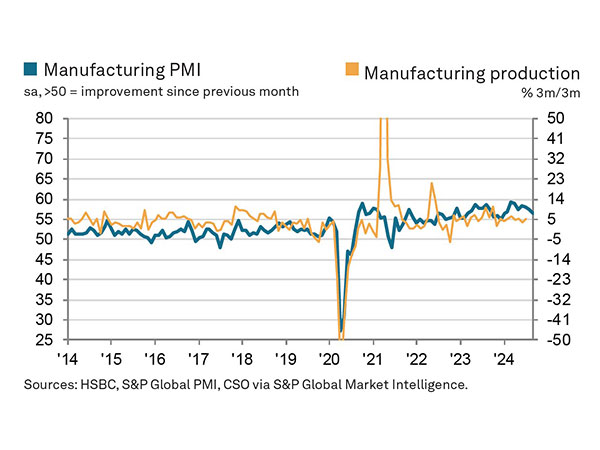India's Manufacturing Sector Growth Dips in September Despite Positive Demand Trends
The HSBC India Manufacturing PMI dropped to 56.5 in September 2024, indicating a slight downturn in the sector's growth. Despite continued expansion, this is the lowest performance since January 2024. Factors such as increased competition, a slowdown in new export orders, and rising input costs contributed to the moderation.

- Country:
- India
India's manufacturing growth experienced a minor setback in September 2024, as indicated by the HSBC India Manufacturing Purchasing Managers' Index (PMI) dipping to 56.5 from August's 57.5. Although the sector remains in expansion territory, this marks its weakest performance since January 2024.
The slowdown in growth is attributed to various factors including heightened competition and a softer surge in new export orders. Domestic demand remained positive, but the rate of expansion was constrained, leading to a modest increase in sales. Export orders notably decelerated, recording an 18-month low growth rate. Despite strong domestic operation, overall production growth slowed, specifically in consumer and capital goods, while intermediate goods production stayed steady.
Input costs rose in September, with manufacturers facing higher prices for chemicals, packaging, plastics, and metals. However, inflation was mild by historical standards. HSBC Chief India Economist Pranjul Bhandari noted a softer momentum in the sector, with slower growth in output and new orders, particularly in export demand. This impacted profit margins, potentially affecting hiring demand, as employment growth slowed for the third consecutive month.
Despite higher input costs, manufacturers raised their selling prices, although the inflation rate hit a five-month low. Purchasing activity continued to grow, driven by new business and production demands, yet at a slower rate than earlier in the year. Employment growth also decelerated, with some firms cutting back on part-time and temporary workers, while those with pipeline projects continued hiring.
Mixed inventory trends were observed, with finished goods stocks declining and raw materials holdings increasing. Business confidence declined, with a mere 23 per cent of manufacturers expecting output growth in the coming year. Overall, business optimism fell to its lowest level since April 2023.
(With inputs from agencies.)
ALSO READ
Sterling Gains Against Dollar Amid UK Inflation Anticipation
RBI's Long-Term Focus on Inflation
U.S. Economy Turns Corner on Inflation, Lael Brainard Declares
India’s WPI Inflation Eased to 1.31% in August 2024
Turning the Corner: White House Adviser Lael Brainard on U.S. Inflation and Housing Challenges










